Microsoft 70-768 Exam Practice Questions (P. 3)
- Full Access (38 questions)
- Six months of Premium Access
- Access to one million comments
- Seamless ChatGPT Integration
- Ability to download PDF files
- Anki Flashcard files for revision
- No Captcha & No AdSense
- Advanced Exam Configuration
Question #11
Note: This question is part of a series of questions that present the same scenario. Each question in the series contains a unique solution. Determine whether the solution meets the stated goals.
You have an existing multidimensional cube that provides sales analysis. The users can slice by date, product, location, customer, and employee.
The management team plans to evaluate sales employee performance relative to sales targets. You identify the following metrics for employees:
✑ Ninety percent or greater relative to sales target values is considered on target.
✑ Between 75 percent and 90 percent is considered slightly off target.
✑ Below 75 percent is considered off target.
You need to implement the KPI based on the Status expression.
Solution: You design the following solution:

Does the solution meet the goal?
You have an existing multidimensional cube that provides sales analysis. The users can slice by date, product, location, customer, and employee.
The management team plans to evaluate sales employee performance relative to sales targets. You identify the following metrics for employees:
✑ Ninety percent or greater relative to sales target values is considered on target.
✑ Between 75 percent and 90 percent is considered slightly off target.
✑ Below 75 percent is considered off target.
You need to implement the KPI based on the Status expression.
Solution: You design the following solution:

Does the solution meet the goal?
send
light_mode
delete
Question #12
Note: This question is part of a series of questions that present the same scenario. Each question in the series contains a unique solution. Determine whether the solution meets the stated goals.
You have an existing multidimensional cube that provides sales analysis. The users can slice by date, product, location, customer, and employee.
The management team plans to evaluate sales employee performance relative to sales targets. You identify the following metrics for employees:
✑ Ninety percent or greater relative to sales target values is considered on target.
✑ Between 75 percent and 90 percent is considered slightly off target.
✑ Below 75 percent is considered off target.
You need to implement the KPI based on the Status expression.
Solution: You design the following solution:

Does the solution meet the goal?
You have an existing multidimensional cube that provides sales analysis. The users can slice by date, product, location, customer, and employee.
The management team plans to evaluate sales employee performance relative to sales targets. You identify the following metrics for employees:
✑ Ninety percent or greater relative to sales target values is considered on target.
✑ Between 75 percent and 90 percent is considered slightly off target.
✑ Below 75 percent is considered off target.
You need to implement the KPI based on the Status expression.
Solution: You design the following solution:

Does the solution meet the goal?
send
light_mode
delete
Question #13
Note: This question is part of a series of questions that use the same or similar answer choices. An answer choice may be correct for more than one question in the series. Each question is independent of the other questions in this series. Information and details provided in a question apply only to that question.
You have a Microsoft SQL Server Analysis Services (SSAS) instance that is configured to use multidimensional mode. You create the following cube:
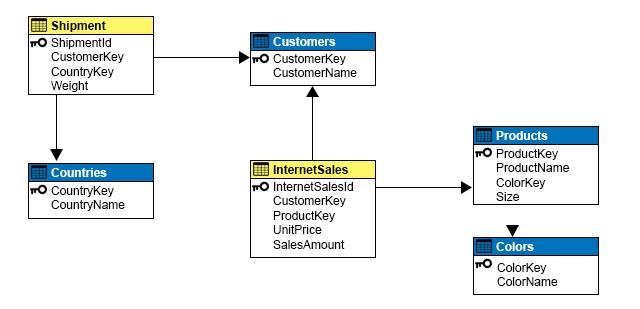
Users need to be able to analyze sales by product and color.
You need to create the dimension.
Which relationship type should you use between the InternetSales table and the new dimension?
You have a Microsoft SQL Server Analysis Services (SSAS) instance that is configured to use multidimensional mode. You create the following cube:

Users need to be able to analyze sales by product and color.
You need to create the dimension.
Which relationship type should you use between the InternetSales table and the new dimension?
- Ano relationship
- Bregular
- Cfact
- Dreferenced
- Emany-to-many
- Fdata mining
Correct Answer:
D
A reference dimension relationship between a cube dimension and a measure group exists when the key column for the dimension is joined indirectly to the fact table through a key in another dimension table, as shown in the following illustration.
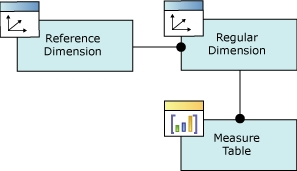
A reference dimension relationship represents the relationship between dimension tables and a fact table in a snowflake schema design. When dimension tables are connected in a snowflake schema, you can define a single dimension using columns from multiple tables, or you can define separate dimensions based on the separate dimension tables and then define a link between them using the reference dimension relationship setting. The following figure shows one fact table named InternetSales, and two dimension tables called Customer and Geography, in a snowflake schema.

You can create two dimensions related to the InternetSales measure group: a dimension based on the Customer table, and a dimension based on the Geography table. You can then relate the Geography dimension to the InternetSales measure group using a reference dimension relationship using the Customer dimension.
Incorrect Answers:
B: A regular dimension relationship between a cube dimension and a measure group exists when the key column for the dimension is joined directly to the fact table.
C: Fact dimensions, frequently referred to as degenerate dimensions, are standard dimensions that are constructed from attribute columns in fact tables instead of from attribute columns in dimension tables.
E: Many to Many Dimension Relationships.
In most dimensions, each fact joins to one and only one dimension member, and a single dimension member can be associated with multiple facts. In relational database terminology, this is referred to as a one-to-many relationship. However, it is frequently useful to join a single fact to multiple dimension members. For example, a bank customer might have multiple accounts (checking, saving, credit card, and investment accounts), and an account can also have joint or multiple owners. The Customer dimension constructed from such relationships would then have multiple members that relate to a single account transaction.
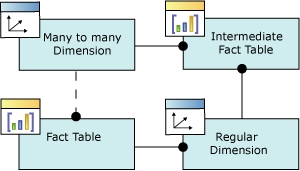
References: https://docs.microsoft.com/en-us/sql/analysis-services/multidimensional-models-olap-logical-cube-objects/dimension-relationships
D
A reference dimension relationship between a cube dimension and a measure group exists when the key column for the dimension is joined indirectly to the fact table through a key in another dimension table, as shown in the following illustration.

A reference dimension relationship represents the relationship between dimension tables and a fact table in a snowflake schema design. When dimension tables are connected in a snowflake schema, you can define a single dimension using columns from multiple tables, or you can define separate dimensions based on the separate dimension tables and then define a link between them using the reference dimension relationship setting. The following figure shows one fact table named InternetSales, and two dimension tables called Customer and Geography, in a snowflake schema.

You can create two dimensions related to the InternetSales measure group: a dimension based on the Customer table, and a dimension based on the Geography table. You can then relate the Geography dimension to the InternetSales measure group using a reference dimension relationship using the Customer dimension.
Incorrect Answers:
B: A regular dimension relationship between a cube dimension and a measure group exists when the key column for the dimension is joined directly to the fact table.
C: Fact dimensions, frequently referred to as degenerate dimensions, are standard dimensions that are constructed from attribute columns in fact tables instead of from attribute columns in dimension tables.
E: Many to Many Dimension Relationships.
In most dimensions, each fact joins to one and only one dimension member, and a single dimension member can be associated with multiple facts. In relational database terminology, this is referred to as a one-to-many relationship. However, it is frequently useful to join a single fact to multiple dimension members. For example, a bank customer might have multiple accounts (checking, saving, credit card, and investment accounts), and an account can also have joint or multiple owners. The Customer dimension constructed from such relationships would then have multiple members that relate to a single account transaction.

References: https://docs.microsoft.com/en-us/sql/analysis-services/multidimensional-models-olap-logical-cube-objects/dimension-relationships
send
light_mode
delete
Question #14
Note: This question is part of a series of questions that use the same or similar answer choices. An answer choice may be correct for more than one question in the series. Each question is independent of the other questions in this series. Information and details provided in a question apply only to that question.
You have a Microsoft SQL Server Analysis Services (SSAS) instance that is configured to use multidimensional mode. You create the following cube:
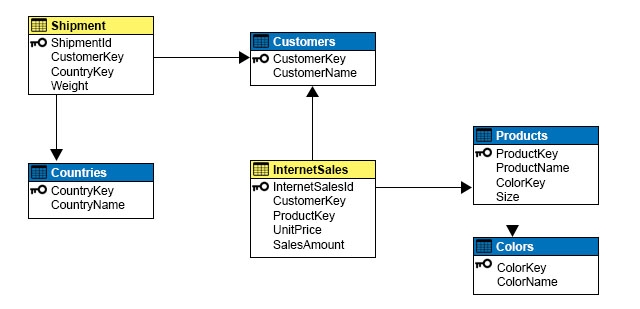
Users need to be able to analyze sales by color.
You need to create a dimension that contains all of the colors for products sold by the company.
Which relationship type should you use between the InternetSales table and the new dimension?
You have a Microsoft SQL Server Analysis Services (SSAS) instance that is configured to use multidimensional mode. You create the following cube:

Users need to be able to analyze sales by color.
You need to create a dimension that contains all of the colors for products sold by the company.
Which relationship type should you use between the InternetSales table and the new dimension?
- Ano relationship
- Bregular
- Cfact
- Dreferenced
- Emany-to-many
- Fdata mining
Correct Answer:
B
A regular dimension relationship between a cube dimension and a measure group exists when the key column for the dimension is joined directly to the fact table.
References: https://docs.microsoft.com/en-us/sql/analysis-services/multidimensional-models-olap-logical-cube-objects/dimension-relationships
B
A regular dimension relationship between a cube dimension and a measure group exists when the key column for the dimension is joined directly to the fact table.
References: https://docs.microsoft.com/en-us/sql/analysis-services/multidimensional-models-olap-logical-cube-objects/dimension-relationships
send
light_mode
delete
Question #15
Note: This question is part of a series of questions that use the same or similar answer choices. An answer choice may be correct for more than one question in the series. Each question is independent of the other questions in this series. Information and details provided in a question apply only to that question.
You have a Microsoft SQL Server Analysis Services (SSAS) instance that is configured to use multidimensional mode. You create the following cube:
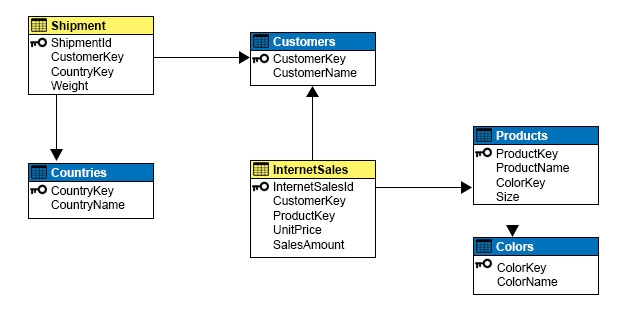
You need to create a new dimension that allows users to list shipments by the country where the product is shipped.
Which relationship type should you use between the Shipment table and the new dimension?
You have a Microsoft SQL Server Analysis Services (SSAS) instance that is configured to use multidimensional mode. You create the following cube:

You need to create a new dimension that allows users to list shipments by the country where the product is shipped.
Which relationship type should you use between the Shipment table and the new dimension?
- Ano relationship
- Bregular
- Cfact
- Dreferenced
- Emany-to-many
- Fdata mining
Correct Answer:
E
Many to Many Dimension Relationships.
In most dimensions, each fact joins to one and only one dimension member, and a single dimension member can be associated with multiple facts. In relational database terminology, this is referred to as a one-to-many relationship. However, it is frequently useful to join a single fact to multiple dimension members. For example, a bank customer might have multiple accounts (checking, saving, credit card, and investment accounts), and an account can also have joint or multiple owners. The Customer dimension constructed from such relationships would then have multiple members that relate to a single account transaction.

References:https://docs.microsoft.com/en-us/sql/analysis-services/multidimensional-models-olap-logical-cube-objects/dimension-relationships
E
Many to Many Dimension Relationships.
In most dimensions, each fact joins to one and only one dimension member, and a single dimension member can be associated with multiple facts. In relational database terminology, this is referred to as a one-to-many relationship. However, it is frequently useful to join a single fact to multiple dimension members. For example, a bank customer might have multiple accounts (checking, saving, credit card, and investment accounts), and an account can also have joint or multiple owners. The Customer dimension constructed from such relationships would then have multiple members that relate to a single account transaction.

References:https://docs.microsoft.com/en-us/sql/analysis-services/multidimensional-models-olap-logical-cube-objects/dimension-relationships
send
light_mode
delete
All Pages
